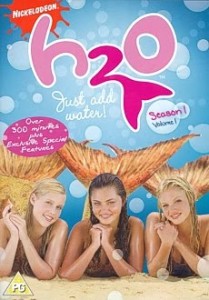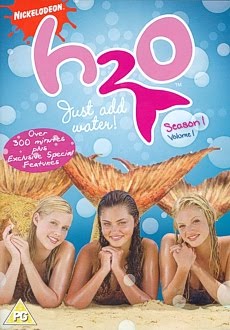
H2O: Just Add Water is a mermaid series for teens and tweens, which ran for three seasons between 2006 and 2010*. Part 1 (this section) considers the series in the context of other mermaid media and reviews season one. Part 2 (over here) reviews season two. Part 3 (over there) deals with season three, wider themes/issues and the upcoming spinoff series, Secret of Mako Island.
(Due to covering three seasons, there are some inevitable spoilers and a few stand-alone episodes are discussed in more detail. However, I’ve avoided discussing the season finales and there will still be a lot of surprises.)
The Modern Mermaid
Early mermaid legends were very male-centric. It was about the man being rescued by the mermaids or being lured to his death. Either way, it was a tale revolving around human men, where mermaids played a side role. When stories turned around to being from the mermaid’s perspective, the male focus stayed. Ariel in Disney’s The Little Mermaid was driven by her attraction to a human man and was willing to give up being a mermaid for him. She wasn’t allowed to have needs and desires outside of that.
There were some early examples which subverted the trend. Splash, a 1984 romantic comedy, had a happy-ever-after that didn’t require the mermaid giving up her tail (though the writers of the TV movie sequel were clearly uncomfortable with that, and tried to reverse the original story). But it’s taken longer to see a full shift to a story where being a mermaid, and the friendships between mermaids/girls, is the central focus.
An example of the female-centric approach is teen movie Aquamarine. Though Aqua believes she’ll win the day by getting a boy to fall in love with her, it’s actually the friendships she forms with the girls that are the important things (as Aqua eventually realises). Such an approach can also include main male characters. The novel Above World (Jenn Reese) has two viewpoint characters – a merboy and mergirl – but it doesn’t become all about the boy. Both characters have important roles in the quest. The mergirl is not an accessory for the merboy (or vice versa).
This is not a universal shift though, with many stories still focusing on the mermaid willing to give up everything for a man/boy, with no focus on female friendship or her own needs. Stories with merboys and mermen as main characters can easily shift into this, such as Legacy Lost (Anna Banks), where the mergirl is there to be beautiful and die tragically, and the story focuses on the merboy’s pain. This is on a level with the old sailor stories, where it was never really about the mermaids.
H2O: Just Add Water is an example of taking the story back to the mermaids. The central conflict is the girls dealing with being mermaids, with a focus on their friendship. They date and are friends with boys, but they don’t exist simply to be part of the boys’ stories.
Review: Season One
Plot Overview
Cleo (Phoebe Tonkin), Rikki (Cariba Heine) and Emma (Claire Holt) are three 15-year-old girls living on the coast of Australia. After getting lost on Mako Island, they fall down into a cave with a pool. The only way out is to swim, but as they do so, the moon comes over the pool and the water bubbles.
The next day, each girl carries out her usual routine. Seconds after they get wet, they turn into mermaids. It isn’t long before they discover they have other powers. Cleo can shape water, Emma can freeze it and Rikki can boil it.
Initially, they try to keep this a secret from everyone, but Cleo’s best friend Lewis (Angus McLaren) finds out. He agrees to help the girls hide their secret and tries to use science to help them, with mixed success.
Much of the series deals with the basic conflict of learning what it means to be a mermaid and how to deal with everyday life. Emma has to give up competitive swimming, which has been her life since she was little. Cleo has to overcome her fear of water and accept she can’t be an ordinary girl. And Rikki just thinks it’s awesome, which is awesome in itself… she’s a much needed counter to the other two girls, confronting them directly for whining when they’re talking about how terrible it is to get special magical powers.
Antagonists
The main antagonist is Zane, a boy the same age as the girls. He’s the local bully, but it’s quickly apparent this is a shield for covering up a poor relationship with his father. He has moments of genuine charm. This rounding out of his character makes him a lot more interesting, as he’s both hateable and likable at the same time. He has the potential to be both a villain and an ally.
A few more infrequent antagonists appear. The least developed is Miriam – she’s a rather stereotypical mean girl. Others include a marine biologist, who gets a look at a cell sample from the girls, and Zane’s father, who intends to build on Mako Island.
I generally liked the characterisation, as the two adult antagonists also had multiple sides to them. Miriam’s shallowness wasn’t ideal, but she also wasn’t a primary antagonist.
What I wasn’t fond of was the girls’ reaction to the biologist, Doctor Denman. Cleo doesn’t believe Denman is really a scientist due to being blonde and pretty. Though the other girls do give Cleo looks, and Emma has checked out Denman’s research, this isn’t behaviour that has any real consequence. Rikki latter joins in criticising Denman’s appearance.
Though this sort of casual internalised misogyny does happen among teens, it’s something I dislike seeing presented as perfectly okay. It would have been nice if someone (and Rikki would have been a good candidate, as she previously criticised the beauty pageant) had made a snarky remark, or otherwise reacted in a way that showed smiting your rival’s looks isn’t ideal. There was plenty of other stuff they could have criticised Denman over.
Allies
Emma comes from a stable family and gets advice from her mother and father. Her parents are shown as a strong partnership, rather than one dominating the other. This is in contrast to Cleo’s family, where her father dominates and mother is often quiet and worried in the background. In both cases, parents provide someone the girls can talk to. It’s nice not to see an over-reliance on parent/child arguments or parents who behave like they’re children and need looking after.
Outside of family, there’s Miss Chatham, a former mermaid from the 1950s. I particularly liked the girls having an older woman to help guide them. It not only highlighted mermaids supporting each other across generations, but that the girls in the ’50s were not so different. The underlying problems they faced were much like the modern mermaids.
The biggest ally, though, is Lewis. As Cleo’s best friend, he’s around a lot of time and does what he can to help. This is the area where the series could have failed, by making it into Lewis’s story – some writers seem to struggle not to do this whenever they have a male character in the group. Overall, this doesn’t happen. Lewis gets his own subplots and plays his part, but he’s one of the group rather than leading the group.
The Siren Effect – Episode Comments
The episode with the biggest potential for failure was about sirens. Cleo turns into one, and her singing causes all the teenaged boys in the area to gather around her.
This theme is often used in a way that promotes rape culture. The girl/woman loses control and the boys/men attack her. This is shown as her fault for being so irresistible (the boys/men couldn’t help themselves, etc). Though a children’s programme will handle this in a more innocent way, the eventual outcome would be boys grabbing, or trying to kiss, the irresistible girl and it all being portrayed as her fault.
Refreshingly, it didn’t go there. Cleo remains in control of her abilities and it never felt like she was at risk (not from the boys anyway). She does initiate contact with one boy, but again, she’s in control.
Overall Views
It was a strong first season, with characters I cared about and antagonists that had more going on than being evil because they were evil. The realities of having to avoid all water were handled well, down to Cleo bribing her sister to wash the dishes. Not being able to get wet in public would impact a lot of things (and they’re lucky they don’t live in England, given the amount of rain here).
Due to using physical tails rather than CGI, the show didn’t have to hold back on underwater shots. One of the lures of such a series is seeing the mermaids getting to be mermaids, so it was a good production decision.
There were some uncomfortable moments of misogyny (such as the criticism of Doctor Denman’s appearance). On the whole though, the season had more female-positive stuff than negative. It was very much the mermaids’ story.
There was a lack of diversity in some areas, such as racial / ethnic and sexualities, but that’ll be discussed more in part three, taking all three seasons into account.
–
* The version I borrowed is the German one, which has all three seasons (it has the option to switch between dubbed German and original English, so isn’t any different other than the language on the credits).
